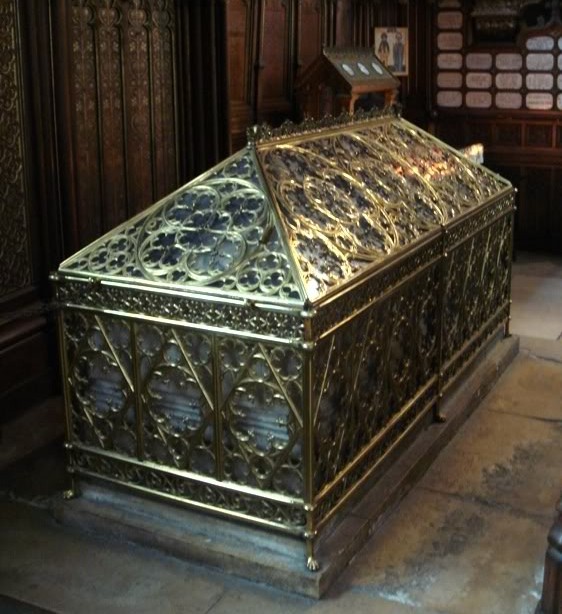By David Powell (Guest Contributor)
 In November 1793, the oldest victim of the Reign of Terror went quietly to her fate. She had already been dead for nearly thirteen centuries, but that did not mollify the revolutionaries who had exhumed Saint Genevieve of Nanterre from the crypt beneath the Parisian abbey that bore her name.
In November 1793, the oldest victim of the Reign of Terror went quietly to her fate. She had already been dead for nearly thirteen centuries, but that did not mollify the revolutionaries who had exhumed Saint Genevieve of Nanterre from the crypt beneath the Parisian abbey that bore her name.
Her ornate, early medieval reliquary, gilded in gold and silver and encrusted with diamonds and other gems, was taken to the city mint over the protest of hundreds of the saint’s admirers. There, behind locked doors, assayers valued the ancient coffin at 23,800 livres. They then dismantled it.
Within, wrapped in white linen, they found “the bones of a cadaver and a head on which there were many deposits of gypsum or plaster.”
They also found a tiny piece of ancient parchment with an inscription: Hic jacet humatum corpus sanctae Genovefae. “Here lies buried the body of holy Genevieve.”
It was an undignified end for the patron saint of Paris. Genevieve was a shepherdess from nearby Nanterre who, as the governing apparatus of the Roman Empire receded from 5th century Gaul, gained widespread fame for her piety and charity. When Attila the Hun, the “Scourge of God,” threatened Paris in 451, a prayer vigil led by Genevieve was credited with saving the city from his wrath.
After her death, she was interred atop the hill that would later be home to the city’s Latin Quarter. Her shrine, just east of the town’s disused Roman forum, quickly became a pilgrimage site. Even in death, she remained active. In the centuries to come, as Paris bloomed around her, every grave threat to the city was met by a procession featuring her sarcophagus: war, plague, famine…even high water. The Marquise de Sevigny described a 1675 procession meant to end a series of flooding rainstorms:
“Monks of every order walk in it, and all the parish clergy and the canons of Notre-Dame, his Grace the Archbishop, in pontifical robes, on foot, and blessing the people right and left all the way to the cathedral. However he walks only on the left side. On the right walks the Abbot of Sainte-Genevieve, barefooted, preceded by 150 monks, also barefooted …The Parliament in red robes and all the higher guilds follow the shrine, which sparkles with precious stones, and is carried by twenty-two barefooted men clad in white. The head of the merchant guilds and five councillors are left as hostages at the Abbey of Sainte-Genevieve until the return of [the saint’s relics].”
By 1793, her fame had become a liability. Her bones were tried for treasonous collaboration with the Bourbon royal family, found guilty, and burned at the Place de Grève (now the Place de l’Hôtel-de-Ville). The few remaining fragments of her body were later reburied at the Church of St. Stephen, where they remain today. Nearby, the city’s Pantheon stands on the former site of her shrine and is the final resting place of Voltaire and other secular titans of France. The building’s intended purpose remains visible, however, in the murals that decorate its vaulted interior, which depict the life of a shepherd girl from Nanterre.
David P. Powell studies ancient and medieval Europe in the graduate history program at Villanova University. When the urge seizes him, he writes about the topic at his blog, Studenda Mira.
Further reading:
Bitel, Lisa. Landscape with Two Saints: How Genovefa of Paris and Brigit of Kildare Built Christianity in Barbarian Europe. Oxford University Press, 2008.
Sluhovsky, Moshe. Patroness of Paris: Rituals of Devotion in Early Modern France. Brill, 1998.
This post first appeared on Wonders & Marvels in March 2010.
